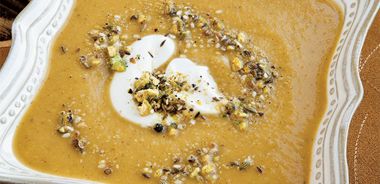Squash Lentil Soup with Dukkah

Dukkah, a fragrant Middle Eastern nut and spice mixture, is a delightful companion to earthy sweet winter squash. Roasting the squash gives this soup an extra layer of flavour. You may also like to add a dollop of sour cream or yogurt. Extra soup can be frozen for future use.
1 medium buttercup or butternut squash, halved lengthwise and seeds removed
3 tsp (15 mL) grapeseed oil or other oil of choice, divided
1 yellow onion, chopped
2 stalks celery, diced
2 garlic cloves, chopped
1 in (2.5 cm) ginger root, chopped
2 tsp (10 mL) curry powder
1/2 tsp (2 mL) cinnamon
1/2 tsp (2 mL) salt, divided
1/4 tsp (1 mL) cayenne or chili powder
5 cups (1.25 L) low-sodium vegetable broth
1 cup (250 mL) red or yellow lentils
1/3 cup (80 mL) unsalted shelled pistachios
1 Tbsp (15 mL) sesame seeds
1 tsp (5 mL) coriander seeds
1 tsp (5 mL) cumin seeds
1/2 tsp (2 mL) fennel seeds
1/2 tsp (2 mL) whole black peppercorns
Juice of 1/2 lime
2 tsp (10 mL) fresh thyme
Sour cream or yogurt, for garnish (optional)
Preheat oven to 400 F (200 C). Brush flesh of squash with 1 tsp (5 mL) oil and place flesh side down on parchment paper-lined baking sheet. Bake for 40 to 45 minutes, or until squash is tender. Scoop out cooked flesh and discard skin.
Heat remaining oil in large saucepan over medium heat. Add onion and cook until softened, about 4 minutes. Add celery, garlic, and ginger. Cook for 1 minute.
Stir in curry powder, cinnamon, 1/4 tsp (1 mL) salt, and cayenne or chili powder; heat for 30 seconds. Pour in vegetable broth and lentils. Bring to a boil, reduce heat to medium low, and simmer until lentils are tender, about 15 minutes.
Meanwhile, to make dukkah, toast pistachios in dry skillet over medium heat until golden brown, shaking pan often, about 4 minutes. Remove pistachios from pan. Add sesame seeds, coriander seeds, cumin seeds, fennel seeds, and peppercorns to skillet and heat until fragrant, stirring often, about 1 minute. Remove from heat and let cool. Once cool, coarsely grind pistachios, spice mixture and remaining salt in mortar and pestle or spice grinder.
Stir squash, lime juice, and thyme into soup. Purée soup, in batches if necessary, in a blender or food processor until smooth. If needed, thin soup with additional broth or water.
Serve soup garnished with a dollop of sour cream or yogurt, if desired, and sprinkle dukkah over top.
Serves 6.
Each serving contains: 269 calories; 11 g protein; 7 g total fat (1 g sat. fat, 0 g trans fat); 43 g total carbohydrates (6 g sugars, 8 g fibre); 330 mg sodium
source: "Good Gourd", alive #373, November 2013





